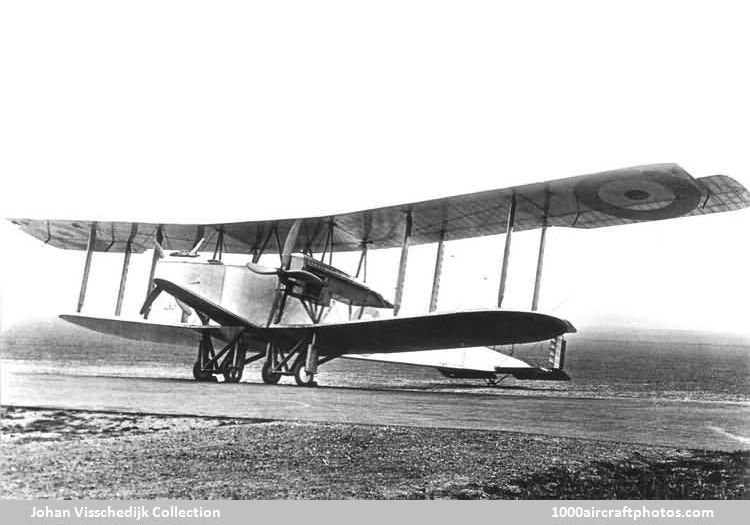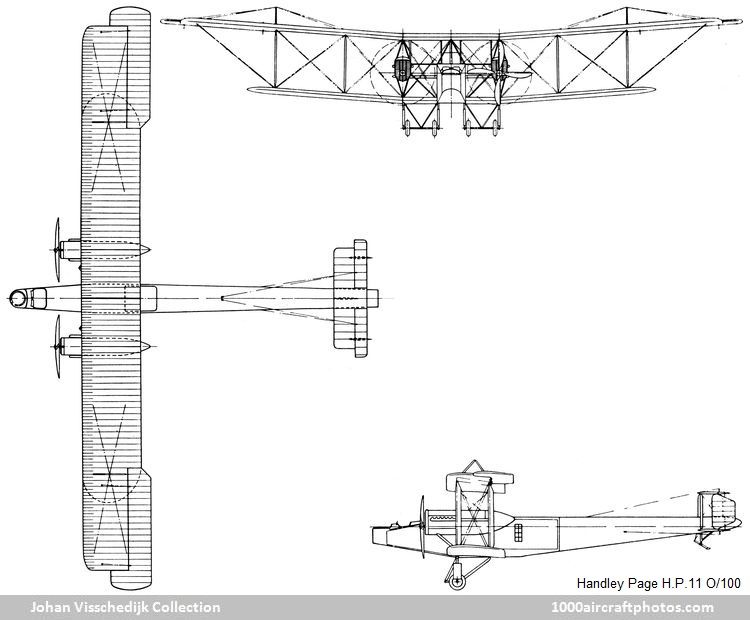09/30/2012. Remarks by Johan Visschedijk: "The British Admiralty's well-founded and wholly admirable policy of taking the offensive and punishing the enemy by bombing was responsible to a great degree for initiating the development of the Handley Page series of large bombing aircraft. Within the first few months of the start of the war the Admiralty had realized that, to implement such a scheme to the fullest extent, an aircraft was needed which could carry a worthwhile bomb load on patrol over water coupled with good endurance. A requirement was drawn up and issued in December, 1914, for a twin-engine two-seater capable of a minimum top speed of 72 mph (115.8 kmh) and to carry six 112 lb (50.8 kg) bombs.
Frederick Handley Page was already firmly convinced of the superiority of the large aircraft for load-carrying and was soon able to submit for the Admiralty's consideration a design for a sizeable biplane with a pair of 120 hp Beardmores. The proposal was received with enthusiasm, with such warmth in fact, as to draw from the worthy and uninhibited Director of the Air Department, Commodore Murray F. Sueter, his classic and uncompromising demand for a 'bloody paralyser' of a bomber.
The challenge was accepted with alacrity by Handley Page and his Chief Designer George Volkert, who redesigned the original layout as the O/100 (retrospectively designated H.P.11). Two 150 hp Sunbeam engines and a span of 100 ft (30.48 m) were specified. No time was lost in constructing the machine, which was ready in less than a year from receipt of the order.
Coincident with this activity in the Handley Page factory at Cricklewood was that in the Rolls-Royce works at Derby, where two new engines, eventually to become renowned as the Eagle and the Falcon, were being evolved specifically for aircraft use. A pair of Eagles, each developing 250 hp, were chosen for the O/100 and were installed as tractors in armored nacelles. The cabin for the crew of the first prototype (s/n 1455) was given bullet-proof glass and armor-plate as extra protection. The load of sixteen 112 lb bombs was carried vertically internally in the center part of the flat-sided, rectangular-section fuselage, which was constructed in three portions.
To enable the O/100 to be housed in a hangar the wings were designed to fold. Of three-bay form, the upper tips overhung considerably and were braced with the usual kingposts and wire. A biplane tail was used, and the main landing gear consisted of twin pairs of wheels. The O/100 was most impressive in appearance and looked every inch the deadly bomber which it was intended to be.
As soon as the prototype was completed it was taken by road in strict secrecy at night on December 17, 1915, the short distance to Hendon for its first flight. Assembly was carried out rapidly within a few hours, so that, at 1:51 p.m. on December 18, the O/100 was able to make a successful take off piloted by Flight Commander J.T. Babington.
The attempt to provide improved crew comfort on long flights by the inclusion of the cockpit enclosure was short-lived, as the structure broke up in flight and was subsequently discarded. The major portion of the armour-plating around the crew was also taken away. No armament was fitted to the first few prototype O/100s, (the second being pictured above) but those ordered to equip the RNAS were modified to incorporate a Scarff ring in the nose and upper and lower positions for Lewis guns in the fuselage to the rear of the wings.
Training in the use of the fine new bomber began at Manston, Kent, in September, 1916, and two months later, in November, the 5th Wing of the RNAS took delivery of its first O/100s at Dunkirk. After being employed on daylight coastal patrol and bombing for a few months, the O/100 was transferred to bombing during the hours of darkness, an operation in which it was increasingly successful despite a shortage of the machines."

